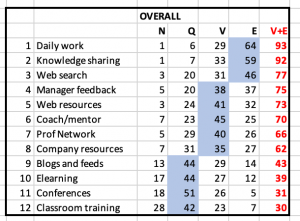 The Learning in the Workplace survey (which asks respondents to rate 12 different ways of learning at work as Not Important (N), Quite Important (Q), Very Important (V) or Essential (E)) has been running since 2010 and now that it has had over 7,500 responses there is enough data to provide a more in-depth analysis of the ways of learning at work that people value.
The Learning in the Workplace survey (which asks respondents to rate 12 different ways of learning at work as Not Important (N), Quite Important (Q), Very Important (V) or Essential (E)) has been running since 2010 and now that it has had over 7,500 responses there is enough data to provide a more in-depth analysis of the ways of learning at work that people value.
The overall profile is shown on the right. The 12 ways of learning are ranked by the aggregated Very Important and Essential (V+E) scores, and the shaded cells show where the most responses where received in each category.
But how do people with different characteristics diverge from this overall pattern? In PART ONE I analyse a number of factors in detail: country of working, organisational size, gender, age, and role in the organisation, and consider what this means for modern workplace learning.
COUNTRY OF WORKING
What about the national culture? Does this effect the value that individuals place on different ways of learning at work. Respondents came from 72 countries around the world, and a significant percentage of responses came from countries like USA (22%) UK and Ireland (20%), and Canada (9%), However, I have grouped other countries together geographically (as follows). Inevitably, these groupings mean that (a) there are still cultural differences within the grouping, and (b) that the sample size of some groups is still quite small – SO FINDINGS SHOULD BE USED WITH CARE!
- Oceania (12%): Australia, New Zealand, Fiji, American Samoa
- Continental Europe (22%): France, Germany, Netherlands, Belgium, Liechtenstein, Luxembourg, Austria, Switzerland, Hungary, Denmark, Sweden, Norway, Finland, Spain Portugal, Italy, Greece, Turkey, Cyprus, Malta, Poland, Bulgaria, Romania, Serbia, Croatia. Slovenia, Czech Republic, Bosnia & Herzegovina, Albania, Ukraine were grouped together to form the Contenting
- Asia: (6%): India, Singapore, Hong Kong, Japan, Vietnam, Korea, Philippines, Thailand, Indonesia, China, Taiwan, Russia, Kazakhstan
- Middle East and Africa (4%): Egypt, Jordan, Saudi Arabia, UAE, Qata, Lebanon, Israel, Yemen, Nigeria, Ghana, Uganda, Cameroon, South Africa, Namibia, Madagascar.
- South American and Caribbean (2%): (Mexico, Brazil, Chile, Peru, Argentina, Jamaica Trinidad & Tobago.
Here are the profiles of the country and country groups, and as you will see there are some differences (a) in the rankings and (b) in the V+E scores which I have highlighted in two divergence (div) columns. Note I have only highlighted (in yellow) numbers that diverge from the overall pattern by more than +5 or more than -5.
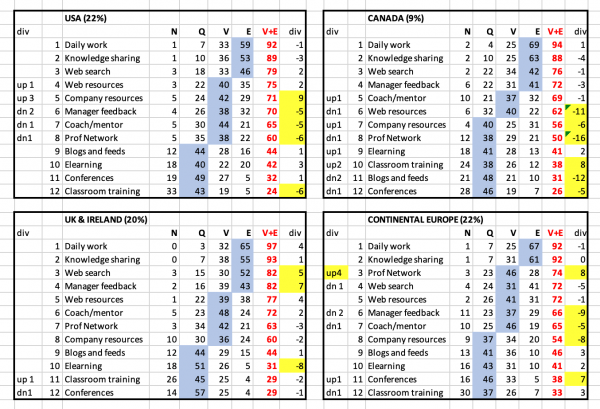
Here are a few thoughts on these 4 profiles; you may be able to read more into them.
- USA: There appears to be the beginnings of a shift from valuing courses to resources. Classroom training is valued less as are managers and coaches, and interestingly professional networking is seen of less value than the average profile.
- Canada: There still seems to be more value placed on traditional, internal ways ways of learning here rather than external resources and networking.
- UK & Ireland: Managers are valued more than the norm, and e-learning seems to be on the decline as a preferred way of learning
- Continental Europe: Professional networking is seen as particularly valuable with manager and coaches seen as less so. Conferences of increased value here too.
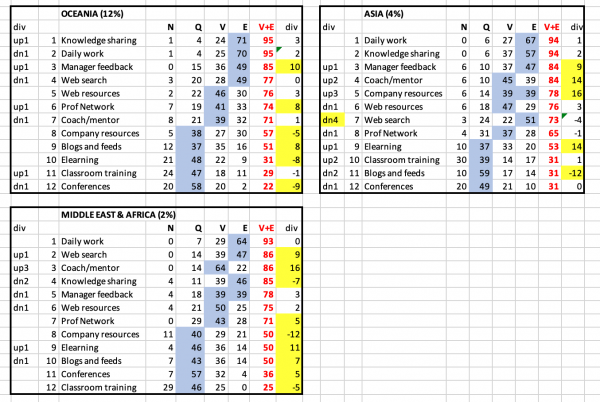
- Oceania (12%): Management feedback is more valued here. External resources – particularly blogs and feeds and professional network – are rated more highly than the norm, and elearning and conferences much less so.
- Asia (4%): Elearning is much more valued here as well as company resources than other regions. Managers and coaches are more highly rated. Blogs and feeds considerably less so.
- Middle East & Africa (2%): A difficult pattern to analyse (probably due to small sample size). Elearning certainly more valued, classrooms not so. Coaches and mentors seem to be particularly important too
ORGANISATIONAL SIZE
Survey respondents were asked to state the size of the organisation they worked in. 66% worked in organisations with more than 250 people, whilst 15% worked in an organisation with under 10 people, 7% with 10-49 people and 11% with between 50 and 250 people. The data suggests that although organisational size does not have a huge influence on the value individuals place on different ways of learning, there are two factors that do make a difference. As can be seen from the profiles below, those who work in very small organisations (1) value external resources, blogs and professional networks more than those who work in large organisations, and (2) value internal resources far less, presumably because they don’t have the budget to create the resources that large organisations do.
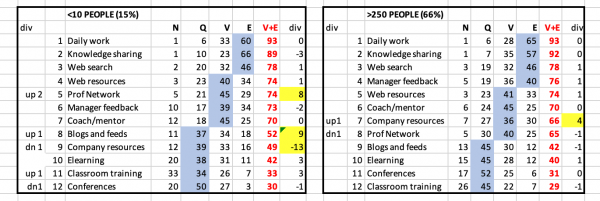
GENDER
63% of respondents were female, and 36% were male. However, a comparison of the two profiles shows no difference in rankings, and only a minor difference in preferences in that females seem to value manager feedback slightly more than males, whilst males seem to prefer professional networking slightly more than females.
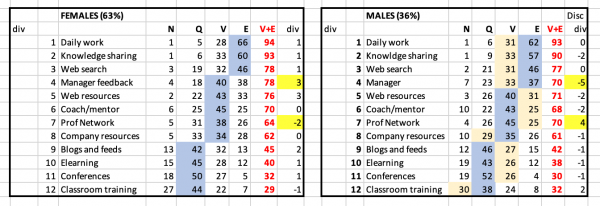
AGE
However, when it comes to age, there are some interesting observations to be made. 9% of respondents were under 30, and 20% were between 31 and 39. Their profiles appear below. As you can see they have a very different rating scale from the overall profile, and place much more value on internal resources and activities than external ones, i.e. they are more focused on doing their current job rather than learning about the wider world of work.
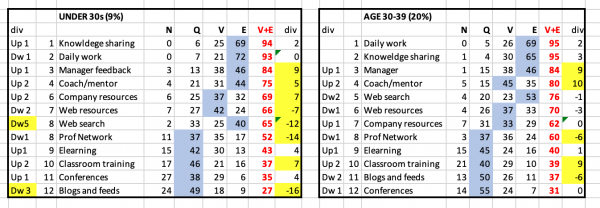
When it comes to those in those in their 40s (34%) and 50s (28%), the external world becomes increasingly more important to them and their manager and/or coach becomes less so. Whilst for those in their 60s (8%), a manager is of decreased value, and they value what they learn externally far more – e-learning and conferences are now more popular, yet at the same time classroom training is seen of little value.
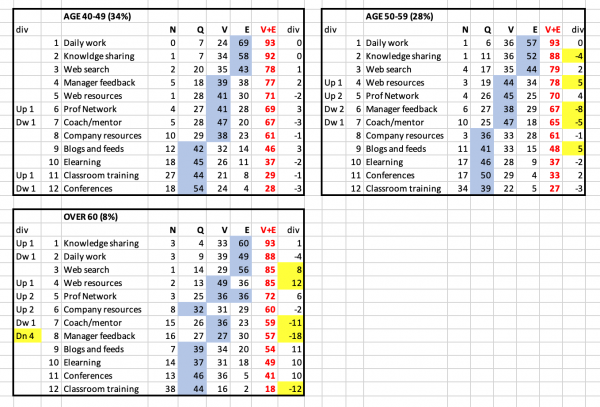
Without getting into the thorny issue of generational stereotypes, I think there is an important (maybe an obvious) point to be made here that workers at different points in their career value different types of learning opportunities. In other words, one size certainly doesn’t fit all! But one think it does highlight is the importance of good managers, coaches and mentors for younger employees
JOB ROLE
So, do these age differences bear out in job roles? For instance, Are they visible in management roles? Of course, age and management roles don’t correlate exactly. (For instance, for those in senior management roles, 9% were under 30, 20% were in their 30s, 34% were in their 40s, 28% were in their 50s, and 8% in their 60s).
Interestingly, however, manager feedback and coaching seemed to be of less value to those in non-managerial roles than for those in management positions. Line managers do, however, seem to value internal activities over external resources and networks although (as with age) this changes as they become more senior. So, there is some correlation between age and management role. But this clearly highlights the potential for L&D to support managers as they make increasing use of external resources to help them in their daily work.
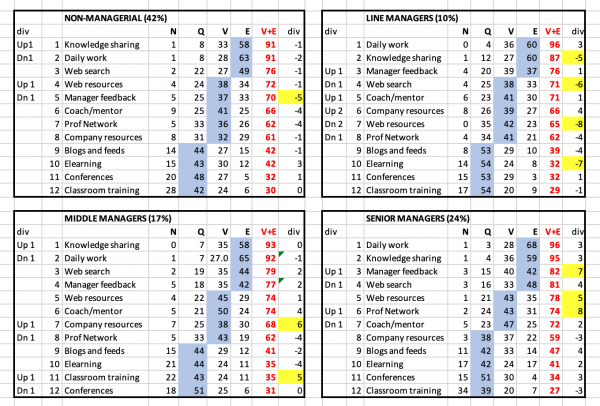
However, I think the most interesting profile of them all is for those who are in non-salaried/freelance positions in the workplace (8%). These people still highly value learning from the daily work, but for them learning from professional networking and access to external resources and blogs and feeds is much more important to them than through internal resources and courses. Interestingly, though conferences are valued less than the average profile – which is probably due to cost and the more significant fact that they can learn more efficiently in other ways.
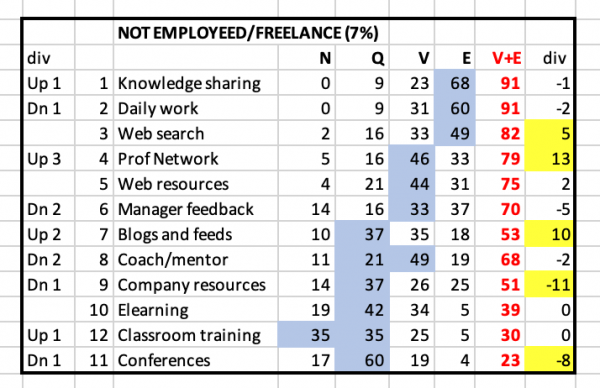
I believe this is the profile that is going to become more and more relevant and important as the work environment changes, where there are no jobs for life and everyone needs to take responsibility for their own learning and development. We have seen (above) that for younger workers this is not yet the case; they are still very focused on the job in hand and not on their own futures, and largely reliant on internal sources for their learning. For L&D it is therefore going to be important to help all workers not just do their day job (and get the most out of their daily work) but help them become aware of the many external opportunities open to them to learn and develop themselves and ensure they are future-ready. What is more, by doing so, they will also help their own organisation to survive and thrive in the new world of work. It will be a win-win for all. This MWL 2020 resource is focused on helping L&D with this new work in the evolving world of work.
In PART TWO of this analysis, I look at each of the 12 ways of learning and compare the results of each of the different profiles above against the overall profile, and discuss some further implications for modern workplace learning
Or you can move on and take a closer look at why classroom training is so unpopular.
Last updated: January 13, 2022 at 13:24 pm